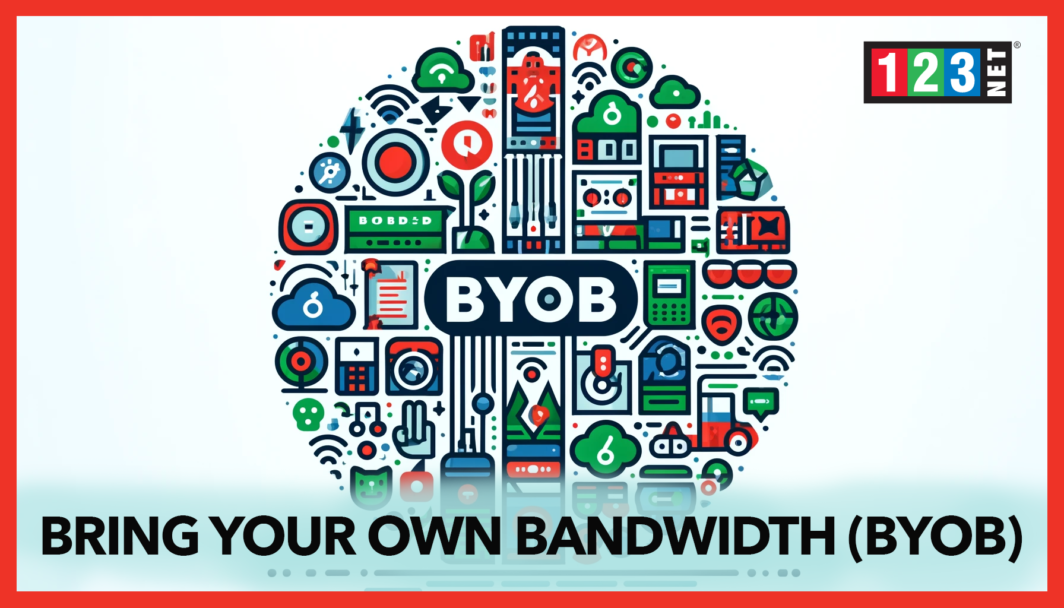
Introduction
Bring Your Own Bandwidth (BYOB) is a revolutionary concept in telecommunications that allows businesses to leverage their existing broadband connections for various telephony services. Unlike traditional models that depend on dedicated telecom lines, BYOB utilizes the internet to deliver voice, data, and video services. This approach is gaining traction due to its cost-effectiveness, flexibility, and scalability. In today’s fast-paced business environment, companies require reliable and adaptable communication solutions, making BYOB a compelling choice.
The importance of BYOB lies in its ability to provide enhanced control and management over communication infrastructure. Businesses can optimize their bandwidth usage, ensuring that they get the most value from their broadband investments. Moreover, BYOB facilitates remote work connectivity, a critical factor in the modern workforce. By understanding the historical background, various implementations, benefits, challenges, and future trends of BYOB, businesses can make informed decisions about adopting this innovative telecommunication solution.
Historical Background and Evolution
Early telecommunications models were heavily reliant on dedicated connections provided by telecom companies. These connections, although reliable, were often expensive and inflexible. The advent of the internet brought significant changes, leading to the development of VoIP (Voice over Internet Protocol), which laid the groundwork for BYOB.
The transition to BYOB began as businesses sought more cost-effective and flexible solutions. Key developments included the widespread adoption of broadband internet and the advancement of internet-based telephony technologies. Milestones such as the introduction of SIP (Session Initiation Protocol) trunking and hosted PBX systems further accelerated the shift towards BYOB, making it a viable alternative to traditional telecommunication methods.
Types of BYOB Implementations
Voice over Internet Protocol (VoIP)
VoIP is a fundamental component of BYOB, allowing voice communication over the internet. VoIP offers numerous benefits, including reduced costs, enhanced flexibility, and improved scalability. Businesses use VoIP for various applications, from basic voice calls to sophisticated unified communication systems. Examples include Skype, Zoom, and other internet-based telephony services.
Hosted PBX (Private Branch Exchange)
A hosted PBX is a cloud-based telephony system that replaces traditional on-premises PBX equipment. Hosted PBX systems operate over the internet, providing businesses with advanced features such as voicemail, call forwarding, and auto attendants without the need for significant hardware investments. The main advantages include lower costs, ease of management, and scalability. However, reliance on internet connectivity can be a limitation.
SIP Trunking
SIP trunking enables businesses to use their existing internet connection to access voice services, replacing traditional phone lines. It involves the use of SIP protocol to establish and manage communication sessions. BYOB in SIP trunking scenarios offers benefits such as cost savings, enhanced flexibility, and better utilization of broadband access. It also supports a range of telecommunication solutions, including video conferencing and multimedia messaging.
Benefits of Bring Your Own Bandwidth
BYOB presents several significant benefits for businesses, making it a compelling choice in modern telecommunications.
Cost Savings
One of the most substantial advantages of bring your own bandwidth is the potential for cost savings. By leveraging existing broadband connections, businesses can avoid the high costs associated with dedicated telecom lines. This reduction in expenses can be particularly beneficial for small and medium-sized enterprises, allowing them to allocate resources more efficiently.
Flexibility and Scalability
Bring your own bandwidth offers unparalleled flexibility and scalability. Businesses can easily adjust their bandwidth usage to meet changing needs without the constraints of traditional telephony systems. This adaptability is crucial in today’s fast-paced business environment, where demands can fluctuate rapidly. Whether a company is expanding its operations or adjusting to seasonal variations, BYOB provides the necessary bandwidth adjustments seamlessly.
Enhanced Control and Management
With bring your own bandwidth, businesses gain greater control over their telecommunication infrastructure. This control includes the ability to manage bandwidth allocation, prioritize traffic, and implement Quality of Service (QoS) measures to ensure optimal performance. Enhanced management capabilities allow businesses to tailor their communication systems to specific needs, improving overall efficiency and effectiveness.
Improved Reliability and Redundancy
Using multiple broadband connections enhances reliability and provides redundancy. If one connection fails, others can take over, ensuring continuous service and minimizing downtime. This redundancy is critical for maintaining business continuity and avoiding disruptions that can impact operations. By having multiple pathways for data transmission, businesses can achieve a more resilient communication infrastructure.
Support for Remote Work
BYOB is particularly advantageous for supporting remote work. As more businesses adopt flexible working arrangements, the ability to use existing broadband connections for telecommunication ensures that remote employees can stay connected reliably. This capability is essential for maintaining productivity and collaboration across distributed teams.
Customization and Integration
BYOB allows for greater customization and integration with other IT systems. Businesses can integrate their telecommunication solutions with existing software and platforms, creating a cohesive and efficient operational environment. This integration can streamline workflows and enhance overall productivity.
Comparison: BYOB vs. Dedicated Connections
Definition of Dedicated Connections
Dedicated connections refer to telecom lines that are exclusively provided for a business’s use, ensuring guaranteed performance and reliability. These lines are often leased from telecom providers and come with service level agreements (SLAs) that promise specific levels of uptime and performance.
Cost Comparison
When comparing costs, BYOB typically offers significant savings. Dedicated connections require substantial investment in infrastructure, along with ongoing maintenance fees. These costs can add up quickly, especially for businesses that need high-capacity connections. On the other hand, BYOB utilizes existing broadband connections, minimizing additional expenses. This makes BYOB an attractive option for businesses looking to reduce telecommunication costs without sacrificing functionality.
Performance and Reliability Differences
Dedicated connections are known for their consistent performance and high reliability, as they are not shared with other users and are less susceptible to congestion. This makes them ideal for businesses that demand uninterrupted service and low latency. However, BYOB can achieve comparable performance with proper bandwidth management and redundancy measures. Implementing Quality of Service (QoS) protocols and having multiple broadband connections can mitigate potential issues, ensuring that voice and data traffic maintain high performance levels.
Use Cases for Each Approach
Dedicated connections are well-suited for businesses with critical reliability and performance requirements, such as financial institutions, healthcare providers, and large enterprises with complex communication needs. These organizations benefit from the guaranteed service levels and low latency that dedicated connections provide.
In contrast, BYOB is ideal for businesses seeking cost-effective, flexible, and scalable telecommunication solutions. Small to medium-sized enterprises, startups, and companies with remote or distributed workforces can benefit greatly from BYOB. The ability to adjust bandwidth usage according to demand and the cost savings from utilizing existing infrastructure make BYOB a versatile and appealing option.
Challenges and Limitations
Potential Technical Issues
BYOB can face technical issues such as bandwidth limitations and network congestion, affecting call quality and data transmission.
Quality of Service (QoS) Concerns
Ensuring QoS is critical in BYOB implementations. Businesses must prioritize traffic and manage bandwidth to maintain high-quality communication services.
Security Considerations
BYOB relies on public internet connections, which can pose security risks. Implementing robust security measures, such as encryption and firewalls, is essential.
Dependency on Broadband Provider
BYOB’s performance is heavily dependent on the broadband provider’s service quality. Businesses need to choose reliable providers to ensure consistent performance.
Future Trends and Opportunities
Emerging Technologies Supporting BYOB
Technologies such as 5G and advanced broadband services are expected to enhance BYOB capabilities, offering higher speeds and lower latency.
Predictions for the Future of Telecommunications
The trend towards BYOB is likely to continue, driven by the demand for cost-effective and flexible telecommunication solutions.
Potential Impact on Businesses and Consumers
BYOB can revolutionize business telephony, offering more control, better performance, and significant cost savings. Consumers will benefit from improved services and lower costs.
FAQs on Bring Your Own Bandwidth
- What is Bring Your Own Bandwidth? A: BYOB is a telecommunication model that allows businesses to use their existing broadband connections for voice, data, and video services.
- How Does BYOB Benefit Businesses? A: BYOB offers cost savings, flexibility, scalability, enhanced control, and improved reliability.
- What Are the Main Types of BYOB Implementations? A: The main types include VoIP, hosted PBX, and SIP trunking.
- How Does BYOB Compare to Dedicated Connections? A: BYOB is more cost-effective and flexible, while dedicated connections offer guaranteed performance and reliability.
- What Are the Common Challenges of BYOB? A: Challenges include potential technical issues, QoS concerns, security considerations, and dependency on broadband providers.
Conclusion
BYOB is becoming increasingly important in telecommunications, offering businesses a cost-effective, flexible, and scalable alternative to traditional telephony solutions. By understanding the benefits, challenges, and future trends, businesses can leverage BYOB to optimize their communication infrastructure and stay competitive in the modern market.




